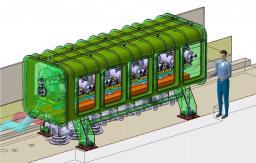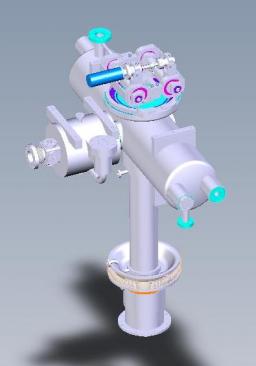
Schematic diagram of the IFMIF-EVEDA prototype accelerator. LBE: low-energy line – RFQ: radiofrequency quadrupole – LME: medium-energy line – SFR-Linac: superconducting radiofrequency linac – LHE: high-energy line.
The International Fusion Material Irradiation Facility or IFMIF is designed to irradiate (with a neutron flux) and characterize the materials used to build future fusion reactors. It will consist of two accelerators, each generating a 125 mA continuous deuteron beam at an energy level of 40 MeV, aimed at liquid lithium target to produce an intense 14 MeV neutron flux (1018 n.m-2.s-1). In view of the high intensity and characteristics required of the beam, a preliminary phase, called EVEDA (for Engineering Validation and Engineering Design Activities) must be carried out. The phase includes the construction of a prototype accelerator (9 MeV at 1 MW) to be installed in Rokkasho, Japan.
The IFMIF-EVEDA prototype accelerator
The IFMIF-EVEDA Engineering Department (SIIEV) is in charge of building the prototype accelerator. It is backed up in this by SACM for all technology relating to the injector, beam dynamics, radiofrequency, cryogenics, and superconducting accelerating cavities, and by the SIS for mechanical design and monitoring the manufacture of components by industrial contractors.
The main obstacle to be overcome is the high beam intensity. Beam loss - no matter how slight - can damage the accelerator and lead to the activation (i.e. radioactivation) of machine components, while significant space charge forces tend to defocus the beam and increase its emittance.
SACM is responsible for building the 100 keV deuteron injector. The IFMIF-EVEDA source is based on the design of the SILHI source, and equipped with an extraction system optimized for a deuteron beam. The low-energy line was designed following an intensive beam dynamics simulation campaign to take into consideration space charge compensation phenomena in the transport line, and to preserve emittance.
SACM also designed beam transport in the medium-energy line, as well as the superconducting linac with its half-wave cavities. Beam dynamics simulations validated the level of beam loss, which must be maintained at less than a fraction for a million.
Cryomodule
The cryomodule of the IFMIF prototype accelerator will be designed to accelerate the deuteron beam exiting the RFQ at 5 MeV up to 9 MeV. It comprises eight superconducting cavities operating at 175 MHz, equipped with power couplers that continuously transfer 70 kW of power to the beam. Eight superconducting solenoids are fitted between each cavity to focus the beam. The Spanish laboratory, CIEMAT, is responsible for the solenoids and for some services concerning the radiofrequency systems.
The studies, which began in late 2008, led to two novel solutions:
1. The horizontal position of the cavities, which makes it possible to install the power coupler vertically and thus reduce the risk of damaging its ceramic leaktight section.
2. A frequency tuning system, integrating a capacitive plunger, which provides a wide tuning range and reduces the distance between the cavities and solenoids. This need for reduced dimensions is required by the beam dynamics to limit the beam losses.
• Accelerator physics and technology › High-Intensity sources and injectors
• Accelerators, Cryogenics and Magnetism Division (DACM)
• LEDA





